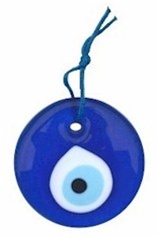Legends – The Nazar – Evil Eye

Temperatures and Seasons in North Cyprus
22 November, 2009
Weather and Climate in North Cyprus
24 November, 2009
Legends – the “Nazar” – Evil Eye
The Nazar, also called the “Evil Eye”
Used by many religions and cultures throughout the world, and a potent symbol against evil from pagan times, is the Nazar. It is used in the Mediterranean and the Middle East, and has links with Judaism, Islam, Hindi and the Christian faith. Usually made of blue glass with a white and black central eye, often ornately decorated with silver, these charms are a popular souvenir, suitable as a gift for man or woman, and come in many different forms. They may be key rings, amulets or bracelets, and range from the size of a one Turkish Lira coin to a large dinner plate.
Used throughout the Mediterranean since before the time of Christ, it is still believed that this symbol has the power to ward off the malevolence of “the evil eye”. Fishing boats are often painted with the “eye” on their prows and as a protective device for the home the Nazar is hung near a door or window as security against any ill intent entering the dwelling.
Two millennia after the birth of Christ, and the acceptance of the Christian religion throughout Europe, the Nazar has lost none of its pagan popularity and is used in conjunction with other icons of good luck. During the Middle-Ages, the “Green Man” symbol continued to be incorporated into the masonry of the Christian churches in those countries that adopted the Christian faith, proving that the pagan Gods of fertility and a bountiful life continued to be revered.
For the charm of the Nazar to work, and for the potency to be fully effective, it must be a gift and not bought for personal use; and once given it must never be passed on to another person. Thus many houses have these good luck symbols hanging in every room and it ensures the manufacturers stay in business. Certainly lucky for some!





